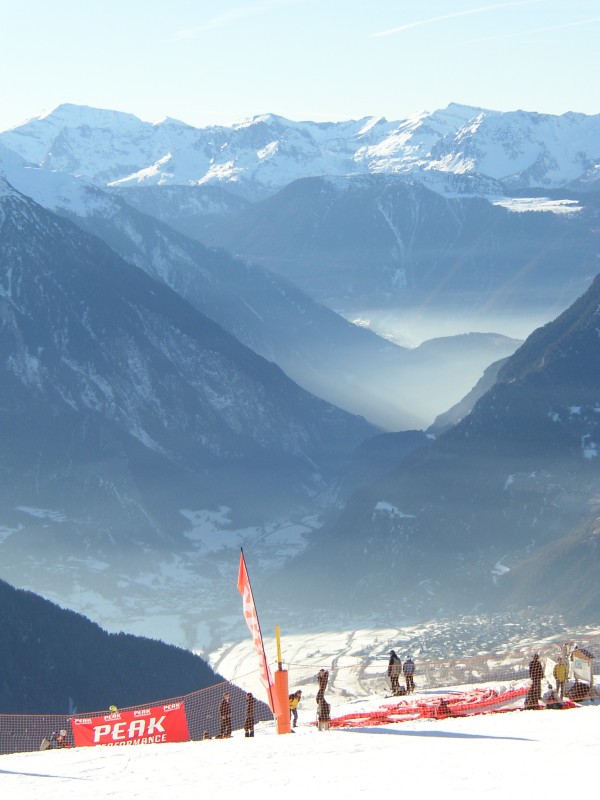For button lifts, the golden rule is that you don't sit on a button lift. It won't take your weight but will just unravel, leaving you flat on your back being laughed at by everyone else. The secret is to stand up, and let yourself be pulled along.
Simple, right?
Well - no. Remember that the lift is going to pull you forwards. If you're unprepared for this, you may well end up leaving your skis where they are and rapidly finding yourself lying on your stomach a few yards up the slope. You think that cartoon's a joke? I guess it's like riding the tube trains in London. You start by hanging on for grim death, and end up not noticing that you're doing anything particularly taxing. The secret is to get plenty of practice!
These days, you're more likely to be whisked up the mountain in the comfort of a chair lift, or a gondola or cable car. These are a lot easier to negotiate. And if you want to be really swish, of course, the ultimate way to get up the mountain is in one of these:
Helicopters are a much more civilised way to get around, believe me.
The International Ski Federation (FIS) has issued a code of conduct that you should follow as you ski or board your way around the resort. There are ten simple rules:
- Have respect for other skiers and snowboarders.
- Don't be reckless, and don't put yourself or others at risk as a result of your actions. Put simply, don't be a dick. And don't maim or kill someone.
- Maintain control of your speed and the manner of your skiing or snowboarding.
- You must always be in control of your progress. This means taking into account your personal ability as a skier or boarder, but also it means responding to the prevailing conditions of terrain, snow and weather, as well as the number of other skiers and boarders around you. Again: don't be a dick. And don't maim or kill someone.
- Choice of route.
- Look where you're going. Pick a route that won't endanger or alarm skiers or boarders ahead of you.
- Overtaking.
- You can overtake another skier or boarder to the right or to the left provided that you leave enough space is left for the person you're overtaking to make any voluntary or involuntary movement. Put it like this: if they wave their sticks about, you don't want to lose an eye (and the HFO know someone to whom this happened.)
- Entering a piste, starting, and moving upwards.
- When you're entering a marked run, when you're starting again after stopping or falling, or if you're moving upwards on the slopes, you must always look up and down the slopes before you set off. Don't put yourself, or others, in danger.
- Stopping.
- Don't stop on the piste if it's narrow, or if visibility is restricted, unless it's absolutely necessary. If you fall in such a place, it's essential that you move clear of the piste as soon as possible.
- Climbing and descending on foot.
- A skier or boarder who is either climbing or descending the piste on foot must keep to the side of the slopes.
- Respect for signs.
- Skiers and boarders must respect all signs and piste markings.
- Assistance.
- In the event of an accident, every skier or boarder is duty bound to render assistance.
- Identification.
- If an accident takes place, every skier or boarder, whether they are a responsible party or a witness, must exchange names and addresses.
They're pretty simple rules, and easy to understand. You'd think that people on the slopes wouldn't have any problem following a set of rules like this, wouldn't you?
Nope. People on the slopes can be selfish, ignorant or just plain stupid. They're out there. And one of them could kill you. Let's face it, skiing is dangerous enough as it is. Always maintain situational awareness on the slopes. Be aware of the conditions and be aware of people around you. We know you can't have eyes in the back of your head, but most of the time you'll hear the idiots coming up on you well in advance.
And as for your own conduct: don't be a dick. Follow the rules, watch your speed, don't get in the way, and enjoy yourself.
I've been skiing in many places over the years, and I have yet to determine what makes a particular slope red and another one black.
There, I've said it. Grading is inconsistent. You ski red slopes one year in one country and the next year you ski an almost identical slope somewhere else and it's a blue. It makes no sense. Why? The basic idea should be pretty simple, after all:
Different countries allegedly have different criteria they use to award colours, but I've skied a black run in one country that would barely have scraped in as a red run somewhere else. In some cases, though, a whole run will be classified as black even though it's only particularly challenging for a small section of its total length. Get to the bottom third of The Wall in Avoriaz and you'll sail down it. It's the vertical drop-off at the top that you have to negotiate that's the fun part...

Novice members of the HFO have sailed easily down the lower half of a black run after being persuaded that the piste markers "were actually dark blue." It's all in the mind, folks...
In Europe, runs are graded in four broad categories, which in order of increasing difficulty are as follows:
| Green runs |
| The easiest slopes, usually where ski school starts. A green run will be very wide and almost flat. They're usually close to the resort, too. |
| Blue runs |
| Once you've got your confidence, you'll find yourself on slightly steeper, slightly narrower pistes. Blue runs are often the long, wide runs back to the resort which are sometimes disparagingly called "motorways" by more experienced skiers. I like motorways! They are excellent for posing on and they're also a good place to practice your carving technique without picking up too much speed. |
| Red runs |
By the time you've graduated to red runs, you'll be after more of a challenge. Reds are steeper still, and may have obstacles which demand some skill to negotiate. These might include fairly steep sections or narrow paths. In some countries you'll also find moguls on a red run. These are regular patterns of bumps which are left by skiers as they turn. If you've only skied on a flat surface before thay can be quite daunting, as they require a different technique to normal skiing. On a red run, you'll need to be able to stop quickly and safely and you should be fully capable of at least a stem turn to get down and still feel happy about it. |
| Black runs |
| This is the category that separates the wheat from the chaff! Black runs can be incredibly narrow and almost vertical, and often have moguls the size of Volkswagen Beetles thrown in for good measure. Some black runs have a mystique all of their own, and they shouldn't be attempted unless you're fully fit and can get down red runs without problems. |
We hope you'll never have to find out how efficient ski resorts are at dealing with incidents or injuries, but if there is an accident and someone is hurt so badly that they can't move to the side of the piste, you should take their skis off (if they haven't already released) and place them, crossed, upslope of where the injured person are lying. Most pistes are patrolled and crossed skis are how you indicate that you need assistance. We've seen the patrol arrive in seconds of someone setting up skis like that.
Injured skiers are either taken off the mountain in a special sledge known univerally as a "blood wagon" or, if things are more serious, by air ambulance. Most resorts have their own medical facilities where common skiing injuries (fractures, sprains, cuts and dislocated joints) can be treated.
And this, of course, is why you should always make sure that everyone in your party always has the appropriate insurance documents with them.
With any luck the injured party be patched up and back on the piste before too long.
This is something the more competitive or goal-focused members of the HFO sometimes struggle to deal with. It's important to remember why you came on holiday in the first place.

Just stop for a moment (at the side of the piste, and not where there's restricted visibility, of course!)
Take a look at that view. Look at the haze and crud in the valleys. You're out of all that. You're above it. Look at those mountains. Feel the sunlight on your face and that crinkly sensation as you breathe in through your nose and the ice crystals form there. Listen to the hissing sound that the snow makes on the base of skis as people schuss past you. Remember how lucky and privileged you are to be doing this. And think about just how good that pile of pommes frites is going to taste when you get back this evening.
You're a skier. Go and enjoy yourself!
